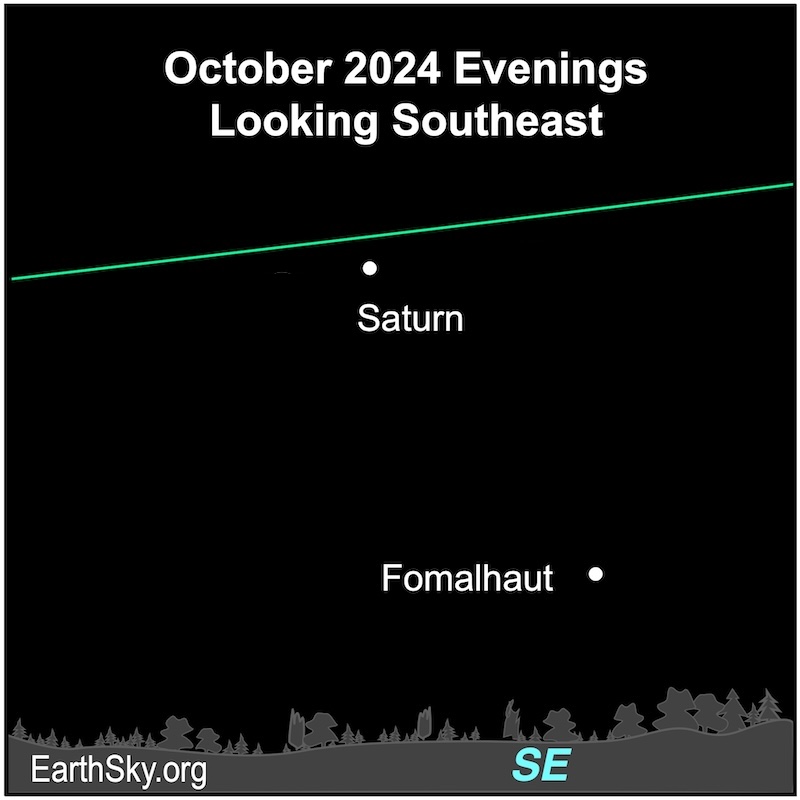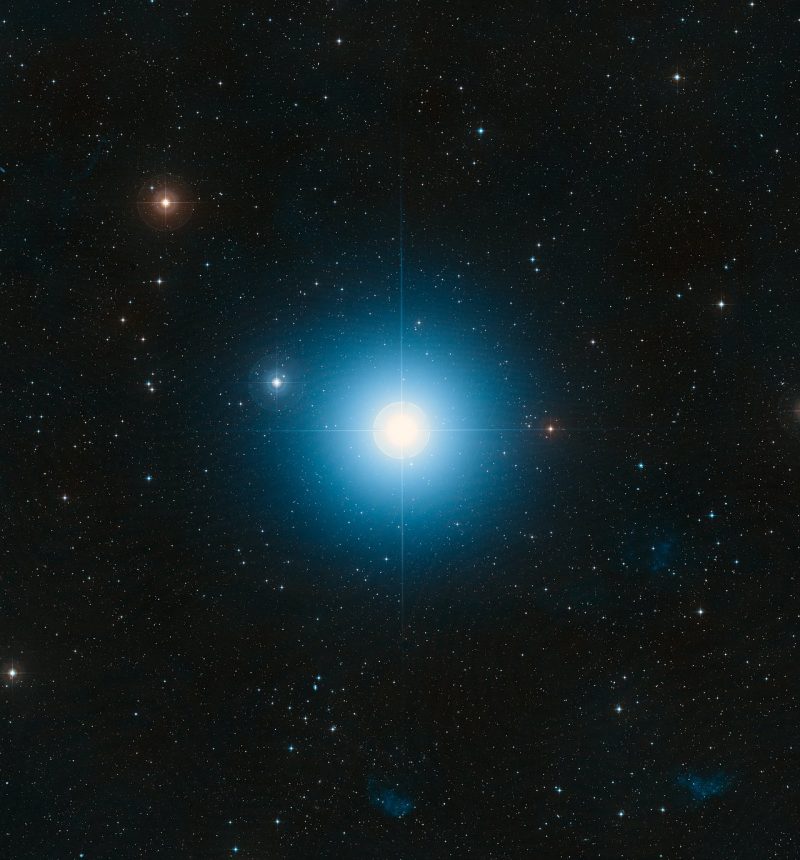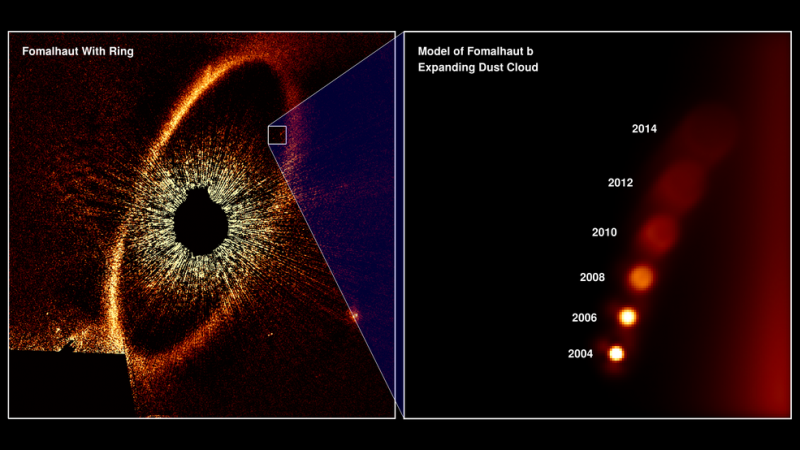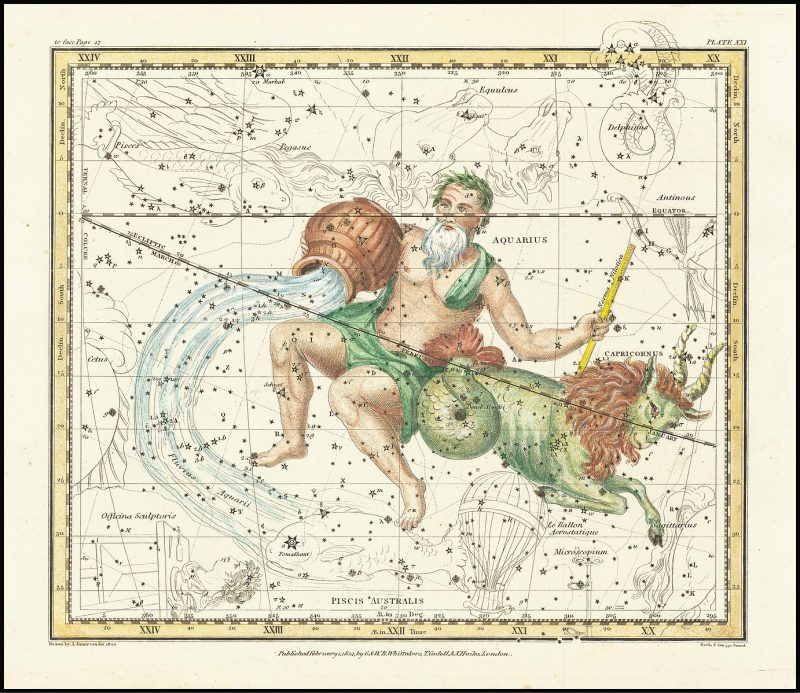
Fomalhaut, bright and lonely
Fomalhaut, aka Alpha Piscis Austrinus, carries the nickname the Loneliest Star. It’s because Fomalhaut is the only bright star in a wide stretch of sky. From the Northern Hemisphere, in most years, Fomalhaut arcs in solitary splendor across the southern sky in autumn. Some also call it the Autumn Star. But in 2024, Fomalhaut isn’t so lonely. The bright planet Saturn is near it in the sky, so that – when you look southward on Northern Hemisphere autumn evenings – you see two bright objects. Fomalhaut will be the one that’s twinkling. Saturn will shine with a steady light.
From the Southern Hemisphere, you’ll look higher up to see Fomalhaut and Saturn in your season of spring.
Keep reading to learn more about Fomalhaut. It’s of special interest to astronomers because it has a debris ring around it. Astronomers think new worlds might be forming in Fomalhaut’s ring, as an early stage in the planet-forming process.

How to see it
Fomalhaut is the 18th brightest star in the night sky. It’s part of the faint constellation Piscis Austrinus the Southern Fish. In a dark sky, you’ll see a half-circle of faint stars of which bright Fomalhaut is a part. This star pattern marks the open mouth of the Southern Fish.
In early September, Fomalhaut is opposite the sun. So, it shines in the sky all night. It reaches its culmination – its highest point in the sky – around local midnight in mid-September.
Fomalhaut culminates at different times on different dates. Here are just a few approximate times and dates of culmination:
July 15: 4:30 a.m. daylight saving time (DST)
August 15: 2:30 a.m. DST
September 15: 12:30 a.m. DST
October 15: 10:30 p.m. DST
November 15: 8:30 p.m. DST
December 15: 5:30 p.m. standard time
The view from different hemispheres
From the Northern Hemisphere, you can see Fomalhaut from as far north as 60 degrees latitude (southern Alaska, central Canada, northern Europe), where it just skims the southern horizon. From the Southern Hemisphere, Fomalhaut appears much higher in the sky. You can use one of several stargazing smartphone apps, some that are free, to help you find it. Or visit Stellarium-Web.org, the free online planetarium, and enter your location and time.
Rings of dust and gas
Fomalhaut is a hot white star about 25 light-years away. It’s almost twice the mass and size of our sun but radiates over 16 times the sun’s energy. Fomalhaut has a companion star less than a light-year away from it. The companion is an orange dwarf star, about 70% the mass of our sun. A third member of the Fomalhaut star system was announced in 2013, a small reddish star about 2.5 light-years from Fomalhaut. From Earth, we see the third star located in the constellation Aquarius instead of Piscis Austrinus.
Fomalhaut itself is a young star, just 440 million years old. That’s in contrast to 4 1/2 billion years for our sun. Fomalhaut is of special interest to astronomers because it has several rings of dust and gas around it, early indications of planets in the process of formation around this star. Astronomers have detected inner debris disks close to the star, within a few astronomical units (AU) from the star.
There’s a much larger, thicker debris ring about 133 AU from the star. A study published in 2008 generated a lot of excitement when Hubble Space Telescope images, taken in 2004, 2006 and 2008 showed an apparent planet very close to this debris ring. Astronomers first thought it was the first directly imaged exoplanet. But data from other telescopes brought that conclusion under scrutiny. And, by 2014, this object was no longer visible to Hubble.
A possible explanation
So what happened? Astronomers think that the “planet” was actually a large dust cloud generated by the collision of two large bodies near the ring. And over time, that dust cloud may have dissipated. And even though it turned out not to be a planet, astronomers were pleased. Catching the aftermath of a collision in a planet-forming disk was good, too! The event provided clues to a deeper understanding about how planets form.

Fomalhaut in history and mythology
The name Fomalhaut derives from the Arabic Fum al Hut, meaning Mouth of the Fish.
In the sky visible from the Northern Hemisphere, the constellation Aquarius the Water Bearer resides above Fomalhaut’s constellation Piscis Austrinus. You can see a zigzag line of stars from Aquarius to Piscis Austrinus. In sky lore, this line of stars represents water from the Jar of the Water Bearer, trickling into the open Mouth of the Fish.
According to Richard Hinckley Allen, Fomalhaut was one of the four guardians of the heavens to the ancient Persians, in 3,000 BCE, called by them Hastorang. (The other guardians were Aldebaran in Taurus, Antares in Scorpius, and Regulus in Leo.) Around 2,500 BCE, Fomalhaut helped mark the location of the winter solstice, meaning that it helped to define the location in the sky where the sun crossed the meridian at noon on the first day of winter. Also Allen also says that in 500 BCE, people worshipped Fomalhaut at the temple of Demeter in Eleusis, in ancient Greece.

Bottom line: Fomalhaut is known as the “lonely one” or “solitary one” because it shines brightly in an otherwise dim patch of sky. But in 2024, Saturn is nearby. Fomalhaut is of special interest to astronomers because of debris rings around it that are possibly the beginnings of a planetary system.
Read more: Fomalhaut has 3 nested belts around the star
The post Fomalhaut is the Loneliest Star … but not in 2024 first appeared on EarthSky.
from EarthSky https://ift.tt/se3d7TU

Fomalhaut, bright and lonely
Fomalhaut, aka Alpha Piscis Austrinus, carries the nickname the Loneliest Star. It’s because Fomalhaut is the only bright star in a wide stretch of sky. From the Northern Hemisphere, in most years, Fomalhaut arcs in solitary splendor across the southern sky in autumn. Some also call it the Autumn Star. But in 2024, Fomalhaut isn’t so lonely. The bright planet Saturn is near it in the sky, so that – when you look southward on Northern Hemisphere autumn evenings – you see two bright objects. Fomalhaut will be the one that’s twinkling. Saturn will shine with a steady light.
From the Southern Hemisphere, you’ll look higher up to see Fomalhaut and Saturn in your season of spring.
Keep reading to learn more about Fomalhaut. It’s of special interest to astronomers because it has a debris ring around it. Astronomers think new worlds might be forming in Fomalhaut’s ring, as an early stage in the planet-forming process.

How to see it
Fomalhaut is the 18th brightest star in the night sky. It’s part of the faint constellation Piscis Austrinus the Southern Fish. In a dark sky, you’ll see a half-circle of faint stars of which bright Fomalhaut is a part. This star pattern marks the open mouth of the Southern Fish.
In early September, Fomalhaut is opposite the sun. So, it shines in the sky all night. It reaches its culmination – its highest point in the sky – around local midnight in mid-September.
Fomalhaut culminates at different times on different dates. Here are just a few approximate times and dates of culmination:
July 15: 4:30 a.m. daylight saving time (DST)
August 15: 2:30 a.m. DST
September 15: 12:30 a.m. DST
October 15: 10:30 p.m. DST
November 15: 8:30 p.m. DST
December 15: 5:30 p.m. standard time
The view from different hemispheres
From the Northern Hemisphere, you can see Fomalhaut from as far north as 60 degrees latitude (southern Alaska, central Canada, northern Europe), where it just skims the southern horizon. From the Southern Hemisphere, Fomalhaut appears much higher in the sky. You can use one of several stargazing smartphone apps, some that are free, to help you find it. Or visit Stellarium-Web.org, the free online planetarium, and enter your location and time.
Rings of dust and gas
Fomalhaut is a hot white star about 25 light-years away. It’s almost twice the mass and size of our sun but radiates over 16 times the sun’s energy. Fomalhaut has a companion star less than a light-year away from it. The companion is an orange dwarf star, about 70% the mass of our sun. A third member of the Fomalhaut star system was announced in 2013, a small reddish star about 2.5 light-years from Fomalhaut. From Earth, we see the third star located in the constellation Aquarius instead of Piscis Austrinus.
Fomalhaut itself is a young star, just 440 million years old. That’s in contrast to 4 1/2 billion years for our sun. Fomalhaut is of special interest to astronomers because it has several rings of dust and gas around it, early indications of planets in the process of formation around this star. Astronomers have detected inner debris disks close to the star, within a few astronomical units (AU) from the star.
There’s a much larger, thicker debris ring about 133 AU from the star. A study published in 2008 generated a lot of excitement when Hubble Space Telescope images, taken in 2004, 2006 and 2008 showed an apparent planet very close to this debris ring. Astronomers first thought it was the first directly imaged exoplanet. But data from other telescopes brought that conclusion under scrutiny. And, by 2014, this object was no longer visible to Hubble.
A possible explanation
So what happened? Astronomers think that the “planet” was actually a large dust cloud generated by the collision of two large bodies near the ring. And over time, that dust cloud may have dissipated. And even though it turned out not to be a planet, astronomers were pleased. Catching the aftermath of a collision in a planet-forming disk was good, too! The event provided clues to a deeper understanding about how planets form.

Fomalhaut in history and mythology
The name Fomalhaut derives from the Arabic Fum al Hut, meaning Mouth of the Fish.
In the sky visible from the Northern Hemisphere, the constellation Aquarius the Water Bearer resides above Fomalhaut’s constellation Piscis Austrinus. You can see a zigzag line of stars from Aquarius to Piscis Austrinus. In sky lore, this line of stars represents water from the Jar of the Water Bearer, trickling into the open Mouth of the Fish.
According to Richard Hinckley Allen, Fomalhaut was one of the four guardians of the heavens to the ancient Persians, in 3,000 BCE, called by them Hastorang. (The other guardians were Aldebaran in Taurus, Antares in Scorpius, and Regulus in Leo.) Around 2,500 BCE, Fomalhaut helped mark the location of the winter solstice, meaning that it helped to define the location in the sky where the sun crossed the meridian at noon on the first day of winter. Also Allen also says that in 500 BCE, people worshipped Fomalhaut at the temple of Demeter in Eleusis, in ancient Greece.

Bottom line: Fomalhaut is known as the “lonely one” or “solitary one” because it shines brightly in an otherwise dim patch of sky. But in 2024, Saturn is nearby. Fomalhaut is of special interest to astronomers because of debris rings around it that are possibly the beginnings of a planetary system.
Read more: Fomalhaut has 3 nested belts around the star
The post Fomalhaut is the Loneliest Star … but not in 2024 first appeared on EarthSky.
from EarthSky https://ift.tt/se3d7TU

Aucun commentaire:
Enregistrer un commentaire